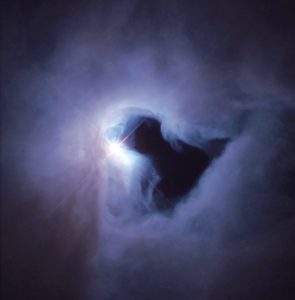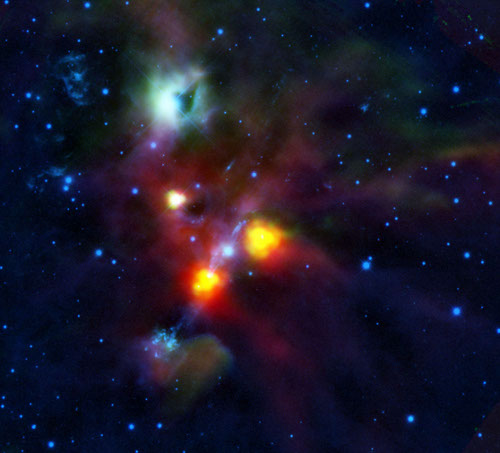| Basic Information | |
| What is this? | A hole through a nebula, blown out by jets and winds of gas from nearby stars |
| Where is it in the sky? | In the constellation of Orion the Hunter, just south of the famous “Orion Nebula” |
| How big is it? | The green nebula in the top left is about a third of a lightyear across |
| How far away is it? | 1500 light years away |
| What do the colours represent? | Red and yellow represent far-infrared wavelengths seen by Herschel, showing cool dust. Green and blue show near-infrared, emitted by much warmer gas and dust. |
Downloads
See this object in:

This image shows a nebula in the constellation of Orion. The bright green patch in the top left is called NGC1999, which is reflecting the light from a star just to the left of it. The dark patch to the right has been seen in visible light, as shown in the image from the Hubble Space Telescope on the right. It was always thought that this was a dark cloud of cold gas and dust which was blocking the light from the star, but which should glow in the far-infrared wavelengths observed by Herschel. The surprise in store was that Herschel sees nothing there either – so rather than a dark cloud it is simply a hole in the nebula.
Stars are born in dense clouds of dust and gas that are being studied in unprecedented detail with Herschel. As thy form, the stars emit strong radiation,and produce jets and winds of gas. These jets and winds blow away the surrounding material, allowing the star to hatch from a cocoon. Although jets and winds of gas have been seen coming from young stars in the past, it has always been a mystery exactly how a star uses these to blow away its surroundings and emerge from its birth cloud. Now, for the first time, Herschel may be seeing an unexpected step in this process.
Investigating further using ground-based telescopes, astronomers found the same story however they looked: this patch looks black not because it is a dense pocket of gas but because it is truly empty. Something has blown a hole right through the cloud. “No-one has ever seen a hole like this,” says Tom Megeath, of the University of Toledo, USA. “It’s as surprising as knowing you have worms tunnelling under your lawn, but finding one morning that they have created a huge, yawning pit.”
The astronomers think that the hole must have been opened when the narrow jets of gas from some of the young stars in the region punctured the sheet of dust and gas that forms NGC 1999. The powerful radiation from a nearby mature star may also have helped to clear the hole. Whatever the precise chain of events, it could be an important glimpse into the way newborn stars disperse their birth clouds.
In this image, red and yellow colours represent the 160 micron and 170 micron light respectively, measured by the PACS instrument on Herschel. The green and blue colours show near-infrared light at wavelengths of 1.6 and 2.2 microns. This light, measured by the NEWFIRM instrument on the NOAO Mayall 4m telescope on Kitt Peak, is emitted by much warmer gas.

